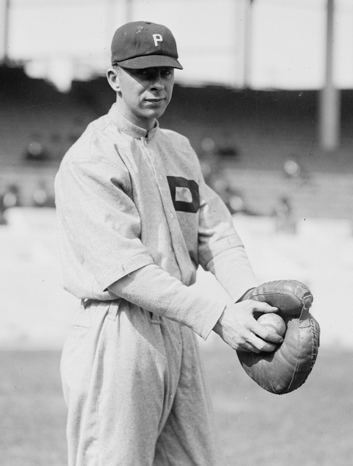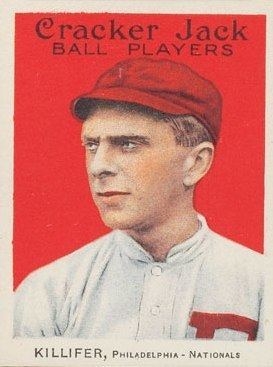Batting average .238 Role Baseball player Name Bill Killefer | Runs batted in 240 Hits 751 | |
 | ||
Teams managed Chicago Cubs (1921 – 1925) | ||
Education St. Edward's University | ||
William Killefer (October 10, 1887 – July 3, 1960) was an American professional baseball player, coach and manager who had a 48-year career in Major League Baseball. Killefer, who was nicknamed "Reindeer Bill" due to his speed afoot, played as a catcher for the St. Louis Browns, Philadelphia Phillies, and Chicago Cubs. He is remembered for being Hall of Fame pitcher Grover Cleveland Alexander's favorite catcher and for being one of the finest defensive catchers of his era.
Contents

Major League career
Killefer made his major league debut on September 13, 1909 with the St. Louis Browns. After the 1910 season in which the Browns finished in last place, Killefer was released to the Buffalo Bisons of the Eastern League. Under the tutelage of Bisons' manager George Stallings, Killefer developed into a refined catcher.
His contract was purchased by the Philadelphia Phillies on August 19, 1911, and he played his first game as a starter on October 3. The Phillies pitcher on that day was Grover Cleveland Alexander, and the game marked the first of 250 times the pair teamed up as a battery in the major leagues. Although he was a light hitter, Killefer became known for his strong defensive skills. In 1913, he led National League catchers with 166 assists, 130 baserunners caught stealing, a 50.6% caught stealing percentage, and finished second in putouts and fielding percentage.
In 1914, Killefer made news when it was reported that he had signed with the Chicago Whales of the Federal League, although he denied the report. When the Phillies offered him a salary increase, he decided to sign with the Phillies, which led the Federal League to file a lawsuit against him and the Phillies. A judge ruled against the Federal League and Killefer remained with the Phillies.
From 1915 to 1917, Alexander and Killefer solidified their reputation as the best battery in baseball, with Alexander posting three consecutive 30-win seasons. Killefer had one of his best seasons for the Phillies in 1917. He led National League catchers with a .984 fielding percentage, as well as in putouts, double plays, and total chances. He also had one of his best seasons offensively with a .274 batting average.
After the 1917 season, in one of the most lopsided trades in major league history, the financially strapped Phillies sent Killefer and Alexander to the Chicago Cubs for two players and $55,000 in cash. With the Cubs, Killefer was credited with strengthening their pitching staff. The Cubs won the 1918 National League pennant before losing to the Boston Red Sox in the 1918 World Series. Killefer had another strong season in 1919, hitting a career-high .286 batting average and leading National League catchers in fielding percentage, putouts and assists. He served as player-manager for the Cubs in 1921 before retiring as a player at age 33.
Career statistics
In a thirteen-year major league career, Killefer played in 1,035 games, accumulating 751 hits in 3,150 at bats for a .238 career batting average along with 4 home runs and 240 runs batted in. He had a career fielding percentage of .977. While he was not a powerful hitter, he possessed a strong throwing arm and a talent for working with pitchers. Killefer led National League catchers in fielding percentage four consecutive seasons from 1916 to 1919. He also led the league three times in putouts, assists and in baserunners caught stealing. Killefer caught 115 shutouts in his career, ranking him 16th all-time among major league catchers.
Killefer's reputation as a defensive standout is enhanced because of the era in which he played. In the Deadball Era, catchers played a huge defensive role, given the large number of bunts and stolen base attempts, as well as the difficulty of handling the spitball pitchers who dominated pitching staffs. Richard Kendall of the Society for American Baseball Research devised an unscientific study that ranked Killefer as the most dominating fielding catcher in major league history.
Managing and coaching career
After his playing career ended, Killefer continued as manager of the Cubs until he was fired after 75 games in 1925. He was hired by St. Louis Cardinals manager Rogers Hornsby as a coach for the 1926 season. The Cardinals went on to win the 1926 World Series with Killefer receiving credit for his help with the pitching staff. In 1927, he was hired by the St. Louis Browns as a coach, and became their manager in 1930. Killefer enjoyed little success as the Browns' manager, never finishing above fifth place as the depression-era team had cut its payroll significantly. He was fired in 1933 and took two years off from organised baseball. He accepted a role as manager for the Sacramento Solons in the Pacific Coast League, leading them to a first-place finish in 1937. He later coached for the Brooklyn Dodgers and managed the minor league Milwaukee Brewers. His managerial record was 524–622 (.457) in nine seasons. Killefer's last on-the-field position in the major leagues was as a coach for the 1942 Philadelphia Phillies. He also served as a scout for the Cleveland Indians, the Phillies and the Dodgers. As a scout for the Indians, Killefer was involved in the signing of Larry Doby in 1947 (the American League's first black player). Killefer was credited with helping the development of such catching standouts as Bob O'Farrell, Gabby Hartnett, Rick Ferrell, and Walker Cooper.
He died in Elsmere, Delaware, at age 72. His brother, Red Killefer, was also a major league baseball player. Political economist Nancy Killefer is a granddaughter.
